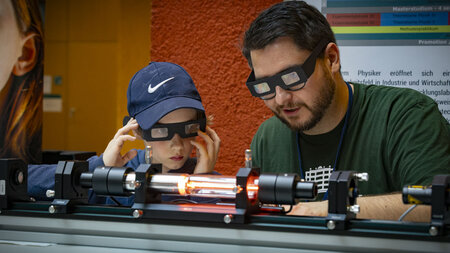Eintrag in der Universitätsbibliographie der TU Chemnitz
Volltext zugänglich unter
URN: urn:nbn:de:bsz:ch1-qucosa-85308
Mach, Thomas
Börm, Steffen (Prof. Dr. habil.) (Gutachter)
Eigenwert-Algorithmen für Symmetrische Hierarchische Matrizen
Eigenvalue Algorithms for Symmetric Hierarchical Matrices
Kurzfassung in englisch
This thesis is on the numerical computation of eigenvalues of symmetric hierarchical matrices. The numerical algorithms used for this computation are derivations of the LR Cholesky algorithm, the preconditioned inverse iteration, and a bisection method based on LDLT factorizations.The investigation of QR decompositions for H-matrices leads to a new QR decomposition. It has some properties that are superior to the existing ones, which is shown by experiments using the HQR decompositions to build a QR (eigenvalue) algorithm for H-matrices does not progress to a more efficient algorithm than the LR Cholesky algorithm.
The implementation of the LR Cholesky algorithm for hierarchical matrices together with deflation and shift strategies yields an algorithm that require O(n) iterations to find all eigenvalues. Unfortunately, the local ranks of the iterates show a strong growth in the first steps. These H-fill-ins makes the computation expensive, so that O(n³) flops and O(n²) storage are required.
Theorem 4.3.1 explains this behavior and shows that the LR Cholesky algorithm is efficient for the simple structured Hl-matrices.
There is an exact LDLT factorization for Hl-matrices and an approximate LDLT factorization for H-matrices in linear-polylogarithmic complexity. This factorizations can be used to compute the inertia of an H-matrix. With the knowledge of the inertia for arbitrary shifts, one can compute an eigenvalue by bisectioning. The slicing the spectrum algorithm can compute all eigenvalues of an Hl-matrix in linear-polylogarithmic complexity. A single eigenvalue can be computed in O(k²n log^4 n).
Since the LDLT factorization for general H-matrices is only approximative, the accuracy of the LDLT slicing algorithm is limited. The local ranks of the LDLT factorization for indefinite matrices are generally unknown, so that there is no statement on the complexity of the algorithm besides the numerical results in Table 5.7.
The preconditioned inverse iteration computes the smallest eigenvalue and the corresponding eigenvector. This method is efficient, since the number of iterations is independent of the matrix dimension.
If other eigenvalues than the smallest are searched, then preconditioned inverse iteration can not be simply applied to the shifted matrix, since positive definiteness is necessary. The squared and shifted matrix (M-mu I)² is positive definite. Inner eigenvalues can be computed by the combination of folded spectrum method and PINVIT. Numerical experiments show that the approximate inversion of (M-mu I)² is more expensive than the approximate inversion of M, so that the computation of the inner eigenvalues is more expensive.
We compare the different eigenvalue algorithms. The preconditioned inverse iteration for hierarchical matrices is better than the LDLT slicing algorithm for the computation of the smallest eigenvalues, especially if the inverse is already available. The computation of inner eigenvalues with the folded spectrum method and preconditioned inverse iteration is more expensive. The LDLT slicing algorithm is competitive to H-PINVIT for the computation of inner eigenvalues.
In the case of large, sparse matrices, specially tailored algorithms for sparse matrices, like the MATLAB function eigs, are more efficient.
If one wants to compute all eigenvalues, then the LDLT slicing algorithm seems to be better than the LR Cholesky algorithm. If the matrix is small enough to be handled in dense arithmetic (and is not an Hl(1)-matrix), then dense eigensolvers, like the LAPACK function dsyev, are superior.
The H-PINVIT and the LDLT slicing algorithm require only an almost linear amount of storage. They can handle larger matrices than eigenvalue algorithms for dense matrices.
For Hl-matrices of local rank 1, the LDLT slicing algorithm and the LR Cholesky algorithm need almost the same time for the computation of all eigenvalues. For large matrices, both algorithms are faster than the dense LAPACK function dsyev.
| Universität: | Technische Universität Chemnitz | |
| Institut: | Professur Mathematik in Industrie und Technik | |
| Fakultät: | Fakultät für Mathematik | |
| Dokumentart: | Dissertation | |
| Betreuer: | Benner, Peter (Prof. Dr. habil.) | |
| URL/URN: | http://nbn-resolving.de/urn:nbn:de:bsz:ch1-qucosa-85308 | |
| SWD-Schlagwörter: | Symmetrische Matrix , Eigenwert , Numerisches Verfahren , QR-Algorithmus | |
| Freie Schlagwörter (Deutsch): | Hierarchische Matrix , Eigenwert , LR Cholesky Algorithms , QR Algorithmus , Bisektionsverfahren , Randelementmatrix , FEM-Matrix , PINVIT , Vorkonditionierte Inverse Iteration , H-Matrix | |
| Freie Schlagwörter (Englisch): | Hierachical Matrix, H-Matrix, Eigenvalue, LR Cholesky algorithm, QR algorithm, Bisectioning, PINVIT, Preconditioned inverse iteration, boundary element matrix, FEM matrix | |
| DDC-Sachgruppe: | Numerische Analysis | |
| Tag der mündlichen Prüfung | 20.02.2012 |




